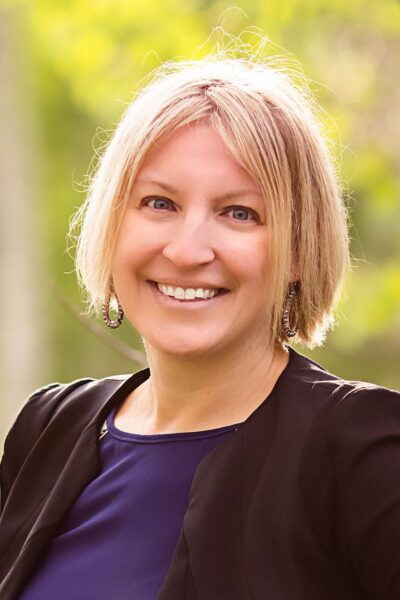
Why a Women’s Bar?
November 2023
Download This Article (.pdf)
Introduction
As CBA president, I am honored to provide you with opportunities to consider innovative ideas and best practices that can improve the quality of your life, your practices, and the quality of law throughout Colorado. As such, I’ve invited leaders from around the state to serve as guest authors for my monthly presidential columns, recognizing that our collective wisdom provides greater value to you than any single leader’s perspective. In these divisive times, as we face tremendous stress and mental health crises, I encourage you to consider the voices of these leaders and the importance of community in helping us lead healthy, thoughtful, and productive lives. My hope is that by listening to each other and considering each other’s perspectives, we can begin to define our collective pathway to success—where our knowledge and insights can lead us to a better tomorrow. This month, we are hearing from Emma Garrison, president of the Colorado Women’s Bar Association, as she considers whether and why it’s important for women to have their own bar association.
—Judge Nathaniel Baca
 My favorite moment in the movie Barbie is when Barbie, shortly after arriving in the real world, sees a billboard with nine contestants from the Miss Universe pageant and enthusiastically exclaims, “Oh look! The Supreme Court!”
My favorite moment in the movie Barbie is when Barbie, shortly after arriving in the real world, sees a billboard with nine contestants from the Miss Universe pageant and enthusiastically exclaims, “Oh look! The Supreme Court!”
In the pink-hued fantasy world of Barbieland, Justice Ruth Bader Ginsburg’s famous quote about when there would be enough women on the Supreme Court—“when there are nine”—is lived out and unquestioned. In the real world, not so much.
Women in the Profession Today
While women are hardly invisible in the practice of law in 2023, women are still underrepresented in many important ways.
According to a 2022 study of private law firms, women comprised the majority of 2L summer associates (55.6%), half of associates (49.3%), but only slightly over a quarter of partners (26.8%).1 A dismal 4.6% of partners were women of color.2 A study of Fortune 1000 companies found that women made up just over a third of general counsels in 2021, which was a significant increase compared to 2020.3
Women judges make up 42% of Colorado’s judicial branch.4 Promisingly, 50% of judges appointed in fiscal year 2022 were women.5 While women currently make up half of Colorado’s General Assembly,6 Colorado has never had a female governor or US senator, and Denver has never seen a female mayor.
The Washington Post reported in October 2022 that since 2017, only 20% of litigants who argued before the US Supreme Court were women.7 And of those women, only 10 were women of color.8 Colorado Politics conducted a similar report this past spring and concluded that more than two-thirds of cases before the Colorado Supreme Court and Court of Appeals and were argued by men.9
“Do We Need Our Own Bar?”
This data underscores why organizations dedicated specifically to advancing women are needed. But this question is still asked frequently and is still worth answering.
Confession time: this was a question I once asked myself. And, more specifically, I asked, “Do I need a women’s bar?” My hesitation centered around the assumption that members of the Colorado Women’s Bar Association (CWBA) were all singularly focused on the fast track and that I was not sufficiently ambitious to truly belong. I also used to feel a lot of discomfort with embracing the label “feminist.”
After choosing “Why a Women’s Bar?” as the angle for this piece, I decided to consult the CWBA archives. And I happened to come across a CWBA newsletter from 1978 addressing this very question. First-ever CWBA President Natalie Ellwood wrote about feeling duped for believing that, upon graduating law school, she would be given the same opportunities as her male counterparts. She shared her frustration about the intense scrutiny women faced when walking into a courtroom. And, most poignantly, she described her loneliness and longing for support and companionship from other women with common interests and goals.
I am forever grateful that I got over my hesitation and decided to give the CWBA a try. What I found was a vibrant group of women who were eager to support me in whatever my goals, whatever my chosen path. The CWBA also opened my eyes to the many struggles that women still face, from being shut out of leadership opportunities to harassment in the workplace. Importantly, the CWBA has been instrumental in my own journey of unlearning white feminism and viewing the issues facing women through an intersectional lens.
There are many “whys” for a women’s bar association, possibly as many “whys” as there are members. Here are an important few:
- Addressing systemic underrepresentation, one member at a time. Our mission is to advance women as leaders in the law. Our Lift! mentorship program10 helps members reach their goals by pairing them with a mentor with experience relevant to their interests. Our educational programs aim to arm our members with confidence and provide transparency around things like making partner, becoming a judge, or moving in-house. The chance to volunteer for committees or take on a leadership role allows members to practice important skills in a low-stakes, supportive environment. Our members also have access to our most valuable resource—our members!—and can connect with each other for help with job searches, business referrals, starting their own practice, or pursuing a leadership role, or for support when things feel hopeless and hard.
- Addressing systemic disparities with a single, powerful voice. The CWBA plays an important role as a thought leader and advocate. The CWBA Public Policy Committee was a key leader in drafting and passing the Colorado Equal Pay for Equal Work Act and in the overhaul of the judicial discipline process in Colorado. CWBA has also been an important partner in coalitions advocating for reproductive rights, addressing harassment in the workplace, and providing for family medical leave. The CWBA’s programming, initiatives, and blog also influence the Colorado legal community at large and help underscore the value of supporting women and promoting them into leadership.
- The visual of an organization run by women leaders. While the CWBA is not quite Barbieland, a board of directors made up entirely of women matters and provides a welcome retreat from a profession still dominated by men.
- The friendships and camaraderie longed for by our founding members. The CWBA is highly regarded for the sense of community it provides and the opportunities for networking, mentoring, and friendships. Sometimes the most important thing we all need to succeed is to know that we are not alone and that others have our back. Support and community are vital to enabling lawyers to thrive, stay in the profession, and maintain their overall well-being.
The Future Is Female
And the future is now. In Colorado, female attorneys under 40 outnumber their male counterparts for the first time since the Office of Attorney Regulation Counsel began collecting this data.11 Women law students have outnumbered men since 2016, and in 2022 made up 55.75% of all students enrolled in ABA-accredited law schools.12
Organizations like the CWBA are needed to ensure these women early in their careers have women role models in all aspects of the practice of law. We want these women to feel supported and valued in their chosen workplaces. We want these women to have the tools they need to succeed, whatever their individual goals may be. And, most important, we want these women to know they’re not alone.
While an all-female US Supreme Court may never come to be, the CWBA remains steadfastly (and joyfully!) committed to making the dream of equal access to all opportunities a reality.
Notes
1. Minority Corporate Counsel Association, U.S. Law Firm Diversity Survey Report 2022 29–32, https://mcca.com/wp-content/uploads/2023/02/MCCA_US-Law-Firm-Diversity-Survey-2022.pdf.
2. Id.
3. Minority Corporate Counsel Association, 2022 Fortune 1000 GC Survey 4, https://mcca.com/wp-content/uploads/2022/12/2022_MCCA-Fortune-1000-GC-Survey.pdf.
4. Colorado Judicial Department, Office of the State Court Administrator, Judicial Diversity Outreach FY2022 Annual Legislative Report 39, https://www.courts.state.co.us/userfiles/file/Administration/Judicial_Diversity/2022%20JDO%20Annual%20Legislative%20Report.pdf.
5. Id. at 2.
6. “Colorado Becomes Second State to Have a Majority-Women Legislature,” The 19th (Nov. 18, 2022), https://19thnews.org/2022/11/colorado-majority-women-state-legislature.
7. Meyer and Raji, “Historically Diverse Supreme Court Hears Disproportionately From White lawyers,” Wash. Post (Oct. 30, 2022), https://www.washingtonpost.com/nation/2022/10/30/supreme-court-justices-diversity-lawyers.
8. Id.
9. Carlick, “White, Male Lawyers Dominate Oral Arguments Before Colorado’s Appellate Courts,” Colo. Pol. (Mar. 11, 2023), https://www.coloradopolitics.com/courts/white-male-lawyers-diversity-colorado-courts/article_b14a5f92-b39c-11ed-928f-bbd8645b76e5.html.
10. The next cohort starts in January 2024. More information is available at https://www.cwba.org/CWBALIFTMentorship.
11. Colorado Office of Attorney Regulation Counsel, 2022 Annual Report 4, https://www.coloradosupremecourt.com/PDF/AboutUs/Annual%20Reports/2022%20Annual%20Report.PDF.
12. Law School Rankings by Female Enrollment (2022), Enjuris, https://www.enjuris.com/students/law-school-women-enrollment-2022.
In the pink-hued fantasy world of Barbieland, Justice Ruth Bader Ginsburg’s famous quote about when there would be enough women on the Supreme Court—“when there are nine”—is lived out and unquestioned. In the real world, not so much.


